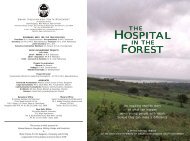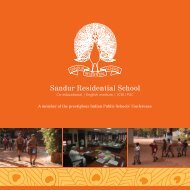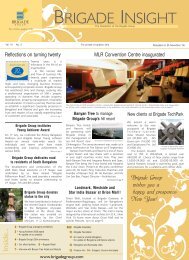Reminiscences of a Wildlife Photographer PHOTOGRAPHY
Reminiscences of a Wildlife Photographer PHOTOGRAPHY
Reminiscences of a Wildlife Photographer PHOTOGRAPHY
Create successful ePaper yourself
Turn your PDF publications into a flip-book with our unique Google optimized e-Paper software.
A beacon <strong>of</strong> light<br />
in the field <strong>of</strong> wildlife photography<br />
“... the language <strong>of</strong> nature ... plain,<br />
simple and utterly brilliant.”<br />
Anyone interested in wildlife photography must have, in all likelihood, heard <strong>of</strong><br />
T. N. A. Perumal. He is a photographer ‘par excellence’ and his pictures, whether pictorial,<br />
portrait or behavioural, are always technically perfect. He never fails to capture his subject with<br />
good composition, correct lighting and sharpness, giving it natural representation in its habitat.<br />
I first met him in 1986 at Bangalore, in the house <strong>of</strong> the great Hanumantha Rao, an icon<br />
<strong>of</strong> his time in wildlife photography. Since then we have been meeting frequently, and my<br />
admiration for his depth <strong>of</strong> knowledge in the art and technology <strong>of</strong> wildlife photography has<br />
always been growing. His interest in wildlife photography was kindled by his chance meeting<br />
in 1960 with O. C. Edwards, an English schoolmaster, while walking in Bannerghatta, near<br />
Bangalore. Edwards was an early pioneer <strong>of</strong> photography in India and Perumal became his<br />
worthy pupil.<br />
Perumal feels that “one good photograph can educate people about the environment much<br />
more than a shelf full <strong>of</strong> books.” He prefers his photographs to talk for him. He believes in<br />
the 3 Ps—Patience and Perseverance always Pays. Sometimes it takes long planning to create<br />
a ‘chance’ to capture an outstanding picture. His famous picture <strong>of</strong> the close-up <strong>of</strong> a barn owl<br />
flying with a feed for its chicks near its nest is a living example <strong>of</strong> his philosophy <strong>of</strong> the 3 Ps.<br />
His present book with his best 252 pictures, both black-and-white and colour, will forever be<br />
a beacon <strong>of</strong> light in the field <strong>of</strong> wildlife photography.<br />
Vivek R. Sinha, ARDS<br />
<strong>Wildlife</strong> photographer, conservationist and<br />
author <strong>of</strong> books <strong>of</strong> his photography <strong>of</strong> tigers<br />
Long before the digital photography revolution, long before the rationale <strong>of</strong> shooting wildlife with a camera<br />
rather than a gun had become fully accepted ... there was T. N. A. Perumal. Black-and-white photography<br />
then was considered an art form, no less than the fine art <strong>of</strong> painting, forests were undisturbed and it was<br />
possible for a man like Perumal to sit for days in hides, machaans, or just quietly by a bird-stocked wetland<br />
and wait for the image to fall magically through his lens onto his camera plate.<br />
Then, when the work <strong>of</strong> gathering images would be done, Perumal would take out his equipment<br />
and spend hour after laborious-but-meticulous hour, bathed in red light, in his developing studio. This is<br />
where the magic all came together, as the brush <strong>of</strong> sunlight and the palette <strong>of</strong> film merged to produce the<br />
masterpieces that are now contained within the covers <strong>of</strong> this book.<br />
I have known, admired and been influenced by the ethics <strong>of</strong> Perumal for over almost four decades<br />
now. Sanctuary Asia, the magazine I edit, owes him a debt <strong>of</strong> gratitude for shining a light on the direction<br />
we eventually took. “Silence, patience, and respect for your subject are the best ingredients for wildlife<br />
photography,” I remember him telling me in Ranthambore where I met him, together with his late friend<br />
M. Y. Ghorpade. A traditionalist in terms <strong>of</strong> his values, Perumal has, however, always been an experimenter.<br />
I will never forget the brilliance <strong>of</strong> the images he shot, using interrupted infrared beams to trigger owls in<br />
mid-flight. Even today he brings nature alive in ways that only he knows.<br />
I am honoured and delighted that he asked me to pen a few words for this book. Anyone interested in<br />
wildlife or in the art <strong>of</strong> photography should sit with him and by osmosis they will learn. And if you cannot<br />
sit with him, then sit with his images. They speak his language, which is the language <strong>of</strong> nature ... plain,<br />
simple and utterly brilliant.<br />
Bittu Sahgal<br />
Editor, Sanctuary Asia<br />
VI<br />
VII
He is his own stern critic ...<br />
Contents<br />
I have known Mr Perumal for over 33 years. We met by chance<br />
at Bannergatta which is about 12 miles from Bangalore. He had a<br />
gun in one hand and a bird, which he had shot, in the other. I was<br />
carrying a camera. I understood his shikaree’s urge quite well since I<br />
myself had used both shot-gun and rifle before laying these down<br />
to take up the camera for wild-life photography. He greeted me with,<br />
“You are Mr. Edwards”, and it sounded almost like the famous words,<br />
“Dr. Livingstone, I presume”. After this we met frequently and went<br />
out to photograph wild-life. His shikaree’s instinct began to be satisfied<br />
with and replaced by wild-life photography. At this he made rapid<br />
progress. Mr. Perumal is a mild-mannered man yet one who possesses<br />
the qualities which make for success. He is his own stern critic and is<br />
not easily satisfied with photographs which might pass muster with the<br />
less critical. His developing and enlarging technique kept pace with<br />
his improvement in tackling wild subjects. He gave up his job as radio<br />
engineer, and was employed by Mr M. Y. Ghorpade <strong>of</strong> Sandur as chief<br />
photographer <strong>of</strong> his “The Sandur Manganese and Iron Ores Ltd.” As<br />
Mr Ghorpade himself is an FRPS and a very keen and accomplished<br />
wild-life photographer, Mr Perumal, in his company, has had the<br />
opportunity <strong>of</strong> seeing and photographing many wild animals both in<br />
India and in Africa. Thus he has an impressive collection <strong>of</strong> wild-life<br />
photographs <strong>of</strong> mammals and birds, and also a fine collection <strong>of</strong> colour<br />
slides.<br />
He has been exhibiting his work both in India and abroad in<br />
international exhibitions with much success. He has won numerous<br />
awards and certificates <strong>of</strong> merit.<br />
Mr Perumal is in demand by organisers <strong>of</strong> exhibitions in India as a<br />
judge for the Nature Section.<br />
His superb pictures <strong>of</strong> the Indian Great Horned-Owl were taken with<br />
electronic flash synchronised with the camera shutter and activated by<br />
the bird breaking a ray <strong>of</strong> connecting light. This device was <strong>of</strong> his own<br />
making.<br />
His distinctions: AFIAP in 1963, EFIAP in 1968, ARPS in 1978,<br />
FRPS in 1979.<br />
Preface 2<br />
Acknowledgements 5<br />
<strong>Reminiscences</strong> <strong>of</strong> a <strong>Wildlife</strong> <strong>Photographer</strong> 9<br />
Pictorial Photography 57<br />
Nature Photography—Black-and-white 69<br />
Nature Photography—Colour 155<br />
Notes to Pictures 306<br />
List <strong>of</strong> Digital Pictures 317<br />
Nature Photography in India: Past and Present 319<br />
T. N. A. Perumal: Pr<strong>of</strong>ile in brief 326<br />
—An Appreciation by O. C. Edwards ARPS, EFIAP, pioneer bird photographer <strong>of</strong><br />
India, on the occasion <strong>of</strong> a “One-Man-Show <strong>of</strong> Wild-Life and Nature Photographs<br />
from India and Africa by T. N. A. Perumal,” organised by A. P. Photographic<br />
Society and Max Mueller Bhavan Hyderabad in 1980.
Preface<br />
“Some unknown, unseen forces direct one’s life, Perumal,” were the words <strong>of</strong> my esteemed<br />
friend and mentor, the late Shri M. Y. Ghorpade <strong>of</strong> Sandur. How true! It is my firm belief<br />
that the good deeds <strong>of</strong> my parents and the benevolent directions <strong>of</strong> our family deity—<br />
Angalaparameshwari <strong>of</strong> Thiruppazhanam, Thanjavur—have been watching over me and have<br />
directed many friends and well-wishers to touch my life.<br />
From a traumatic start to an enriching new life<br />
I have no recollection <strong>of</strong> seeing my mother. She delivered me into this world and left me<br />
when I was ten months old. I lost my father to meningitis when I was in school. Turmoil<br />
and helplessness followed, days filled with fear <strong>of</strong> penury and relentless family tensions and<br />
squabbles.<br />
My hobbies—radio, electronics, reading, wildlife and shikar literature, to name a few—were<br />
passports to a new world; one that exposed me to mentors, friends and new situations ... As<br />
I have said in my essay, later in this book, “a new chapter opened for me, which has been an<br />
eventful one filled with travel and enriching wildlife and photographic experiences”.<br />
Evolution: from gun to camera<br />
I was introduced to the discipline and intricacies <strong>of</strong> target shooting. As a rifleman, I made<br />
forays into forest and jungle with shooting <strong>of</strong> one kind in mind. Thankfully, my shikar days<br />
and experiences were limited. I soon exchanged gun for camera and embarked on more<br />
enlightened adventures. I must say, however, that my short stint as a hunter, when I studied<br />
wildlife at close quarters, gave me a valuable understanding <strong>of</strong> animal and bird behaviour,<br />
body language, habits and vocalisations. This knowledge has served me well in my career as a<br />
photographer.<br />
Sharing the journey<br />
I have visited fascinating forests and jungles, swamps and sanctuaries, across India. I have even<br />
been fortunate enough to go on a photo safari in East Africa. <strong>Wildlife</strong> photography rewards<br />
the patient photographer with exhilarating moments and memories, <strong>of</strong>ten set in magical<br />
environments. I have had many. For years, my family and friends have been trying to persuade<br />
me to record my experiences and their natural outcome—photographs—in a book. Their<br />
consistent encouragement has given gave me the confidence to overcome my trepidation and<br />
bring out this book <strong>of</strong> my life’s work.<br />
The rationale <strong>of</strong> ‘<strong>Reminiscences</strong>’<br />
The task <strong>of</strong> selecting photographs seemed intimidating. Having a rationale to guide the<br />
selection helped (it also gave a logical flow to the book).<br />
For a brief while, early in my career, I was interested in pictorial photography. Some <strong>of</strong><br />
my work in this genre makes its appearance in the first section <strong>of</strong> this book. The two<br />
following sections feature the results <strong>of</strong> my lifelong passion: wildlife and nature photography.<br />
I have experience in all three mediums <strong>of</strong> photography—conventional black-and-white, colour<br />
transparency and digital. So I have selected photographs that seem to best represent my work<br />
in each, under the broader categories <strong>of</strong> black-and-white and colour.<br />
I share the rich experiences my career choices have gifted me in an initial essay. My<br />
thoughts on the changing nature <strong>of</strong> nature photography in India, a practical guide to wildlife<br />
photography and notes on some selected photographs appear at the end <strong>of</strong> the book.<br />
There are many people who have contributed to, and vastly enriched, my journey as a<br />
photographer. They are gratefully remembered on the following page.<br />
I hope going through this book gives you some <strong>of</strong> the joy that creating it has given me.<br />
2 3
<strong>Reminiscences</strong> <strong>of</strong> a <strong>Wildlife</strong> <strong>Photographer</strong><br />
My very first bird photograph (1960)<br />
Oriental White-Eye at nest<br />
<strong>PHOTOGRAPHY</strong> has always enthralled me. Clicking pictures <strong>of</strong><br />
scenery, friends, relatives and animals with borrowed Kodak Baby<br />
Brownie, 120 Box Brownie or folding pocket bellows cameras gave me<br />
immense joy and a proud sense <strong>of</strong> capturing memorable images. This<br />
hobby is a natural extension <strong>of</strong> my early penchant for drawing during<br />
my school days.<br />
All things mechanical, electrical and electronic fascinated me.<br />
‘Popular Mechanics’ was a big influence on my choice <strong>of</strong> hobbies.<br />
In school, I won prizes in the hobby section for a model house with<br />
streetlights powered by a battery and a flying model <strong>of</strong> a fighter plane<br />
made <strong>of</strong> thin cardboard, rubber band and propeller carved out <strong>of</strong> light<br />
wood. Coincidentally the prize was the classic: Around the World in<br />
Eighty Days. Evening bazaar in K. R. Market, which used to be flooded<br />
with post-World War II U. S. Army disposal electronic gadgets, was<br />
my favourite haunt. All my pocket money (the princely sum <strong>of</strong> four<br />
annas a week) was spent on collecting gadgets for my experiments in<br />
radio and electronics. Assembling a crystal radio and other electronic<br />
gadgets occupied my mind. Words cannot describe my excitement when<br />
I successfully assembled a valve radio receiving signals from Radio<br />
Australia—and I could hear the laugh <strong>of</strong> the kookaburra, Voice <strong>of</strong><br />
America and Big Ben <strong>of</strong> BBC crackling in my set.<br />
Natural history books, shikar classics and true-life adventure<br />
stories were another source <strong>of</strong> endless fascination. They were my<br />
favourite reading, transporting me into a world <strong>of</strong> jungles and wild<br />
animals. Later, this world would become a reality. I have wandered<br />
through such environments, in Bannerghatta and elsewhere, in the<br />
company <strong>of</strong> people like my good friend Nanjegowda, the Shikari <strong>of</strong><br />
Sampigehalli, or my staunch friend, philosopher, guide and fellowphotographer,<br />
Y. Upendra.<br />
One has to celebrate the magic and mystery <strong>of</strong> the forest atmosphere.<br />
I have marvelled at red wattled lapwings on an aerial sortie, giving their<br />
agitated did-he-do-it calls, warning <strong>of</strong> an intruder. Words cannot do<br />
justice to the elation one feels walking through the familiar incessant<br />
drizzle that defines a forest in the monsoon season, listening to the<br />
soothing sounds <strong>of</strong> water dripping from wet branches to the leafy forest<br />
floor beneath. Nor can I describe the happiness I feel at hearing forest<br />
symphonies like those <strong>of</strong> the bulbuls—red vented, white browed and red<br />
whiskered—as they flit from one patch <strong>of</strong> forest cover to another. The<br />
lively cackling calls <strong>of</strong> grey partridges emerging from the fields around<br />
the forest will always symbolise the spirit <strong>of</strong> countryside and forest to<br />
me. The forest represents so much, and is represented by so many …<br />
and I’ve not even come to the impact that its animal inhabitants have<br />
had on me.<br />
My love <strong>of</strong> photography, reading and the outdoors—in combination<br />
with my love for things mechanical—has shaped my thoughts, my<br />
choices and my career. It has given me a lifetime <strong>of</strong> experiences and<br />
memories, some <strong>of</strong> which I share with you in the following pages …<br />
8 <strong>Reminiscences</strong> <strong>of</strong> a <strong>Wildlife</strong> <strong>Photographer</strong> 9
Pictorial Photography<br />
In the early years <strong>of</strong> its existence, the world-renowned Mysore Photographic Society <strong>of</strong> Bangalore<br />
counted more pictorial photographers than nature enthusiasts in its membership. This was not the<br />
case for long. The reason for the reverse trend—a preference for nature / wildlife photography—was<br />
because the parameters <strong>of</strong> pictorial photography are ill-defined and very subjective.<br />
In nature photography, the parameters are clear: the subject has to be nature and no manipulation<br />
is permitted. Truthful statement is the most important criteria. In pictorial photography, the subject<br />
can be animate or inanimate; it is its treatment, one’s personal expression and vision that is important.<br />
Of course, nature can be pictorial.<br />
The following pages cover a selection <strong>of</strong> my work as a pictorialist; a brief interest that was soon<br />
replaced by a lifelong fascination with nature / wildlife photography. I must add that my early attempts<br />
at pictorial photography were at the insistence <strong>of</strong> the great stalwart in pictorial photography, the late<br />
C. Rajagopal, who was eager that I explore the genre.
Pair <strong>of</strong> Green bee-eaters<br />
perched on Calotropis plant<br />
in a pictorial composition<br />
Merops orientalis<br />
Moon and owl<br />
(superimposed)<br />
Thiruvadavur,<br />
Madurai, Tamil Nadu.<br />
Kalkere, Bannerghatta,<br />
Bangalore, Karnataka.<br />
58 59
Black<br />
white<br />
&Photographs
Wild buffalos Bubalus bubalis Kaziranga, Assam<br />
Gaur Bos frontalis Nagarahole <strong>Wildlife</strong> Sanctuary, Karnataka.<br />
78 79
Colour Photographs<br />
Analog and Digital
Nilgiri tahr<br />
mother and kid<br />
Hermitragus<br />
hylocrius<br />
Nilgiri tahr mother and kid Hermitragus hylocrius Rajamalai, Eravikulam National Park, Munnar, Kerala.<br />
Rajamalai,<br />
Eravikulam<br />
National Park,<br />
Munnar, Kerala.<br />
192 193
Indian antelopes or blackbucks sparring Antelope cervicapra Maidenahalli Blackbuck Reserve, Karnataka.<br />
Common langur<br />
Semnopithecus entellus<br />
Bandipur National Park, Karnataka.<br />
200 201
Medium egret landing Mesophoyx intermedia Ranthambore, Rajasthan.<br />
Common kestrel (female) Falco tinnunculus Hesarghatta, Bangalore, Karnataka.<br />
238 239















